TALKING BOOBY TRAP
SURPRISE ENEMY SPIES WITH THE SOUND OF YOUR OWN VOICE.

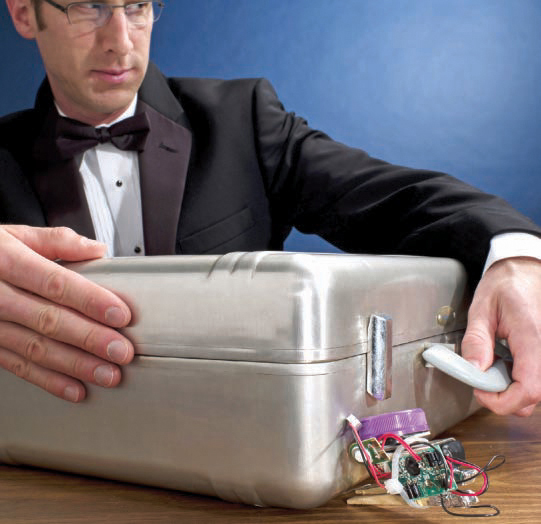
Photograph by Garry McLeod
THE TELL-TALE TRAP: You set the trap, they get the scare. “Villain! Admit the deed!”
Having trouble with people snatching your top-secret stuff? Need help getting some privacy? Here’s a sneaky gizmo you can make to keep those snoops away. It’s a Talking Booby Trap: record your personalized message or sound effect, then hide it in a strategic place. When it’s disturbed, the intruders will hear your surprise warning message telling them to “Get lost!”
MATERIALS
9V Recording Module, RadioShack part #276-1323. This is a pre-wired record/playback unit complete with audio board, speaker, and controls that will record up to 20 seconds of sound in nonvolatile memory. There are actually 2 different versions of this part; try to find the one with the separate wired microphone. It’s much better, with a louder and clearer sound!
9-volt battery
Clothespin serves as a spring-loaded booby trap and as the switch that triggers the sound
Rubber band
Aluminum duct tape
Wire
Plastic cap from 1gal milk jug
Super glue aka cyanoacrylate glue
Zip ties
Double-sided foam tape
Soldering iron, solder
Wire cutters
Small bit of brass strip (optional) with tiny screws (2)
Drill (optional)
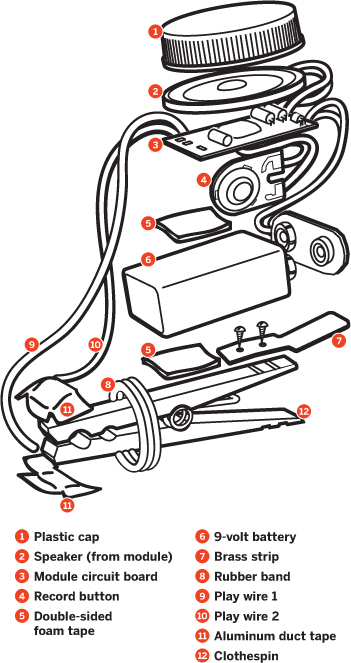

Illustrations by Bob Knetzger
BUILDING THE BOOBY TRAP
1. Disassemble the clothespin — the wire spring is too stiff for our purpose. Reassemble the pin as shown in Figure A (next page) so that the spring is used as a fulcrum pivot. Wrap a rubber band around the jaws of the clip a couple of times. Slide the rubber band closer or farther from the fulcrum to adjust the tension. The clip should open easily, but still be able to close all the way.

TO PINCH A THIEF: Fig. A: Take apart and reassemble a clothespin.
For an easier-to-use booby trap, add an optional extension to the top leg of the clothespin. Bend a small strip of stiff brass so that it lies flat when the clothespin is held open. Drill 2 small holes in the brass and attach it to the clothespin with tiny screws (Figure B).

Fig. B: Add an optional brass extension to the clothespin.
2. Wrap the jaws of the clothespin with the aluminum tape. Poke a small hole in the aluminum and attach the stripped end of a short wire (about 5" long) to each jaw. Twist the wire and crimp the tape over it firmly to make a good electrical connection (Figure C). You’ll be soldering the other ends of these 2 wires to traces on the recording module’s circuit board.

Fig C: Metal tape on the ends of the clothespin serves as contacts for the spring-loaded switch.
3. Install the 9-volt battery and test the circuit: press and hold the Record button (the red LED goes on) and speak loudly into the microphone. Release the Record button when finished. Press the gray button on the PC board to hear your recording.
You can improve the sound significantly and protect the naked speaker by adding a resonant chamber/cover. Use a plastic bottle cap from a gallon milk jug — it’s just the right diameter. Super-glue it to the front of the speaker (Figure D).

Fig. D: A small plastic cap improves the speaker’s sound.
4. Now modify the circuit to wire up the clothespin. Remove the battery. Find the gray rubber-domed Play switch on the PC board (Figure E). Bend the 3 metal tabs on the back and remove the button.
Photography by Bob Knetzger
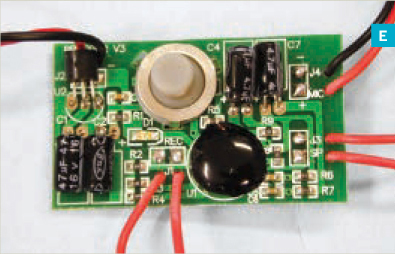
Fig. E: The sound recording module we’ll be using.
5. Feed a wire from the clothespin jaw through 1 of the tab holes and over the edge of 1 of the 2 switch traces. Carefully solder the wire to the first trace only — don’t short out the traces! Do the same thing for the second jaw wire and solder it to the second trace (Figure F).
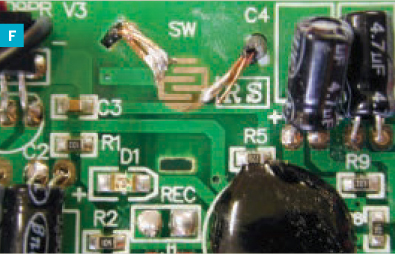
Fig. F: Remove the Play switch button on the circuit board. Feed the clothespin wires through 2 of the tab holes.
Now the clothespin will act as a Play switch: when the jaws touch together, the sound plays. Try it! To prevent the sound from playing, place a slip of paper between the jaws as an insulator.
6. To finish, stick the battery to the top of the clothespin with double-stick foam tape, and then stick it to the circuit board with more foam tape. Foam-tape the speaker on top, then use cable ties through the center of the spring to cinch everything together. Tuck in the microphone and Record switch wires to neaten it all up (Figures G and H).

Fig. G: Booby trap in set position.
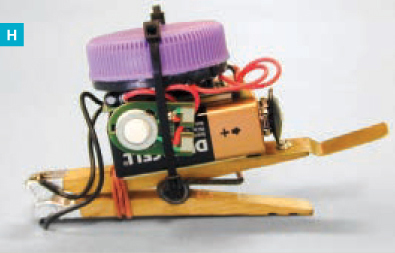
Fig. H: Booby trap in triggered position. Adjust rubber band tension as needed.
SETTING UP THE BOOBY TRAP
After you record your own message and sound effects, you can use the Talking Booby Trap in lots of ways:
» Place a diary, journal, or any object on the brass tab. The weight of the object keeps the clothespin open and armed. Camouflage the booby trap by placing something else in front. If anyone lifts the book — whoop! whoop! — the alarm goes off. The snoop is busted!
» Use the Talking Booby Trap to shame your lunch-lifting co-workers. Hide it behind your food inside the fridge at work. If anybody touches it, the talking booby trap blasts: “Keep your hands off my lunch!” Now everybody will know the identity of the secret food thief!
» Tie a string to a small piece of paper and slip it between the clothespin jaws. Then tie the other end to any pilferable object. You’ll know if anyone tries to take it, because pulling the string trips the booby trap: “Step away from the camera!” You can use thin monofilament fishing line instead of string for a nearly invisible alarm.
» Any bit of paper can act as the bait in your trap to catch a thief.
» Open the Talking Booby Trap and slip it under a closed door. If anybody opens the door, you’ll know it. “Hey, you kids — get back in bed!” Or record a scolding “Bad dog!” message to keep pets in their place while you’re away. You can also arm a drawer or sliding door.
» On a more positive note, you can leave a friendly audio reminder for someone special. Arm their cellphone or car keys and they’ll hear you say: “Don’t forget — romantic dinner tonight!” They’ll really get the message from the spy who loves them!
Bob Knetzger ([email protected]) is an inventor/designer with 30 years’ experience making fun stuff. He’s created educational software, video and board games, and all kinds of toys, from high-tech electronics down to “free inside!” cereal box premiums.

